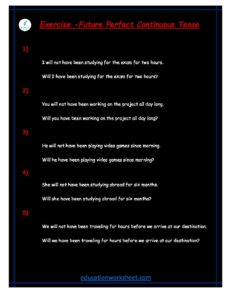Perfect Continuous affirmative examples
Perfect Continuous affirmative examples
Formation of the Present Perfect Continuous Tense:
To form the present perfect continuous tense in the affirmative, we use the following structure:
Subject + have/has + been + present participle (verb + ing)
Let’s break down the components of this structure:
- Subject: This refers to the person or thing performing the action. It could be a pronoun (e.g., I, you, he, she, it, we, they) or a noun (e.g., John, the team).
- “Have” or “Has”: The choice between “have” and “has” depends on the subject. “Have” is used with plural subjects (e.g., we, they), while “has” is used with singular subjects (e.g., he, she, it).
- “Been”: This is a form of the auxiliary verb “be.” In the present perfect continuous tense, “been” is used to indicate the ongoing nature of the action.
- Present Participle: This is formed by adding “-ing” to the base form of the verb (e.g., play → playing, work → working). The present participle emphasizes the ongoing action.
Now, let’s explore the various situations in which the present perfect continuous tense is used and provide numerous affirmative examples for each.
1. Actions That Started in the Past and Continue into the Present:

This usage of the present perfect continuous tense highlights actions or situations that began at some point in the past and are still ongoing in the present. These actions are often characterized by their duration and may or may not continue into the future.
Examples:
- She has been studying at the university for three years.
- They have been living in this neighborhood since 2010.
- The company has been developing a new product for the past six months.
2. Expressing an Action with an Emphasis on Duration:
The present perfect continuous tense is particularly useful when you want to emphasize the duration of an ongoing action, which can convey a sense of effort, commitment, or endurance.
Examples:
- He has been working on this project all night.
- They have been practicing the piano for hours.
- I have been learning Spanish for a long time.
3. Actions That Have Just Ended:
This tense can also be used to describe actions that have just ended and are still relevant to the present situation.
Examples:
- She has been cleaning the house, and it looks spotless.
- They have been rehearsing their performance, and they’re now ready to go on stage.
- I have been cooking dinner, and it’s almost ready.
4. Actions in the Future with a Present Perspective:
In some cases, the present perfect continuous tense can be used to talk about future actions from a present perspective. This is often done when making polite requests, offers, or plans.
Examples:
- I have been thinking about it, and I can help you with the presentation.
- She has been considering your proposal and will get back to you soon.
- We have been planning a surprise party for your birthday.
5. Expressing Ongoing Habits:
While the present perfect continuous tense is primarily used to describe ongoing actions, it can also convey recurring habits, especially when combined with time expressions like “always,” “constantly,” or “often.”
Examples:
- She has always been talking about her dream to travel the world.
- They have been constantly complaining about the noise from the construction site.
- I have been often visiting that bookstore to browse new releases.
6. Actions with a Result in the Present:
This tense can be used to describe actions that have a result in the present. In these cases, the action may have recently concluded, but its effect is still evident.
Examples:
- I have been exercising regularly, and I feel much healthier now.
- They have been renovating their house, and it looks amazing.
- She has been practicing her guitar skills, and her playing has improved.
7. Events or Conditions That Impact the Present:
The present perfect continuous tense is also employed to describe events or conditions that have an impact on the present, especially when introducing or explaining a situation.
Perfect Continuous affirmative examples

Examples:
- The road has been blocked due to a landslide, so we can’t drive through.
- The weather has been unpredictable lately, with sudden changes.
- The internet has been unreliable, causing issues with our work.
8. Reporting Recent Actions or Developments:
When relaying recent actions or developments in a narrative or news context, the present perfect continuous tense is a useful choice for creating a sense of immediacy.
Examples:
- The company’s stock has been plummeting in the last hour.
- Emergency services have been responding to the accident in record time.
- The scientists have been conducting experiments to understand the phenomenon.
9. Continuous Emphasis on an Ongoing Process:
The present perfect continuous tense is also used when there’s a need to focus on the process of an action rather than its completion. This is especially common when contrasting with the present perfect simple tense.
Examples:
- She has been learning how to dance, not just for a single performance.
- They have been exploring different culinary traditions, not just tasting dishes.
- He has been studying for the exam, not just memorizing facts.
10. Describing Ongoing Relationships or States:
This tense can describe ongoing relationships or states, emphasizing their continuous nature.
Perfect Continuous affirmative examples

Examples:
- They have been dating for five years.
- The team has been working together for a long time.
- We have been living in harmony with our neighbors.
In all of these situations, the present perfect continuous tense serves to express the continuity, relevance, and ongoing nature of actions or situations. It’s a dynamic tense that allows for nuanced communication and a deeper understanding of the temporal aspect of events.


